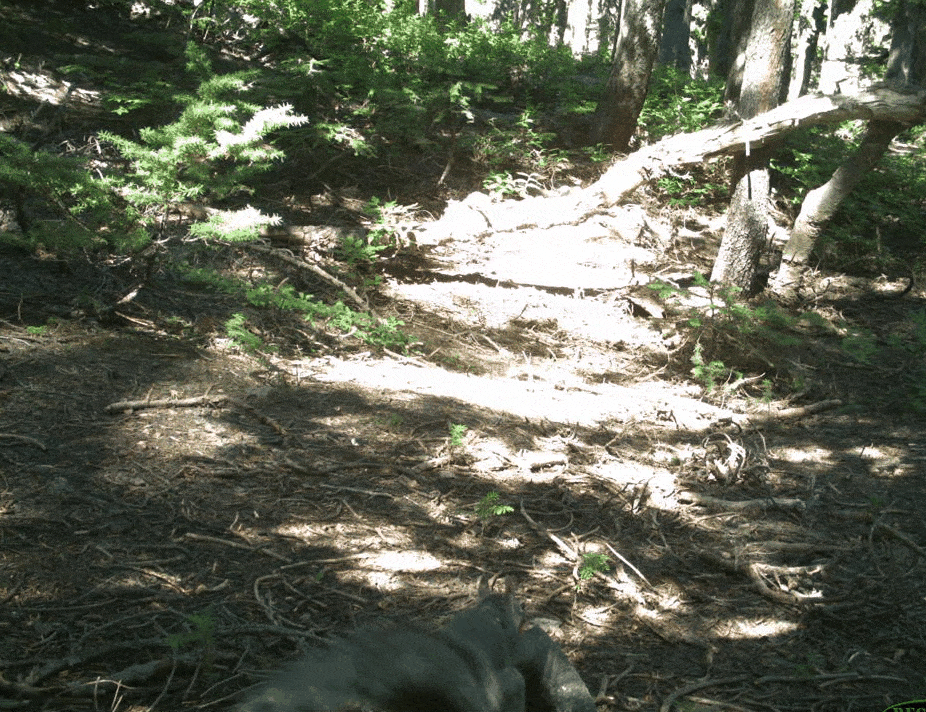Cascadia Wildlife Blog
News from the Wolverine Tracking Project and more
early fall wildlife camera detectionsFall is here! With the changing temperature, we also see changes in the grasses, plants, and trees of the forests as they make their seasonal shifts. Animals are affected as well and many adjust by switching to different foods or traveling to different locations. Some start making major preparations for winter, including storing large amounts of food and scouting out snug places to hibernate in. Some of these changes are evident on the latest photos back from our camera survey. Here we share the most interesting ones as summer has turned into autumn!  Western gray squirrels, like this one, have been frequent visitors to our camera sites. This one has found a large fire cone and is seen dragging it past the camera- maybe to find a more private place to eat or maybe to store it for the upcoming winter! Here is an unusual sighting for us, a short-tailed weasel! Since they are so small, this is a zoomed in look at them. They are in the mustelid family, which includes Pacific marten, minks, river otters, and wolverines! Take a look at this northern flying squirrel leaping across the forest floor! Although common, they are rarely seen since they are only active at night. As this one pauses for a second, you can see the distinctive fold of skin on their side, which they use to glide through the air. This is not true "flight" as their name implies, but still very unusual for a mammal! Striped skunks made several visits recently to some of our sites. Always late in the evening or early in the morning, like this one. We don't know the reason for the increase in activity, but it is very interesting to see! This charming critter stopped by for a perfect pose! Yellow-bellied marmots, also known as "rockchucks", typically live in rocky, high elevations like this one. They are the largest species in the squirrel family in this state, weighing up to 11 pounds- the size of the average house cat! They are also closely related to groundhogs. They are known for their long hibernation and a distinct high-pitched whistle alarm call, used to alert their kin when they sense danger which sends everyone scurrying back to safety of their burrows. We also had a Sierra Nevada fox sighting! This subspecies of red fox has three genetically determined color phases: silver (which can appear black), "cross" (which is a combination of silver and red), and the more familiar red. This one's fur is mostly black in color with some silver guard hairs, giving it a "frosted" look! On this day, a deer was seen munching away on a tidbit found right in front of the camera! Their diet will change now as the lush summer growth is over and they find other tasty things to browse. Elk were seen, often just one or two, as seen here walking through the woods. They will likely start moving into different areas of the mountain as the season changes. A large black bear comes through this site. There were so many great photos, we have more to share of them! At another site, another adult black bear came by. This one helps show the incredible differences in color they can have (compare to the one above)! Black bears can be black, brown, cinnamon, blonde, blue-grey, and even white! About one quarter have white chest markings as well. Scientists think this variety likely helps them adapt to the different environments they live in. There were also little bear sightings! This youngster plays around at the base of this tree where some old stumps are. This final bear also appears to be a young, based on its size. It explores the area, even rolling around under the log before deciding to wander off to find more fun and adventure! Last, but not remotely least, a mountain lion walks through! With a swish of its tail, it disappears into the night. We were thrilled to see this magnificent animal on the survey! We hope you enjoyed seeing some of the best animal detections from our recent camera photos. As this season winds down, we say good-bye to the warm weather and look forward to the coolness of fall. All the wildlife in the forests are feeling it too and we get glimpses into their lives with our cameras. We love sharing our findings, so please come back again next month for our end of the season report!
0 Comments
Leave a Reply. |
Categories
All
Past Posts
May 2024
|
|
|
Copyright © 2021
|